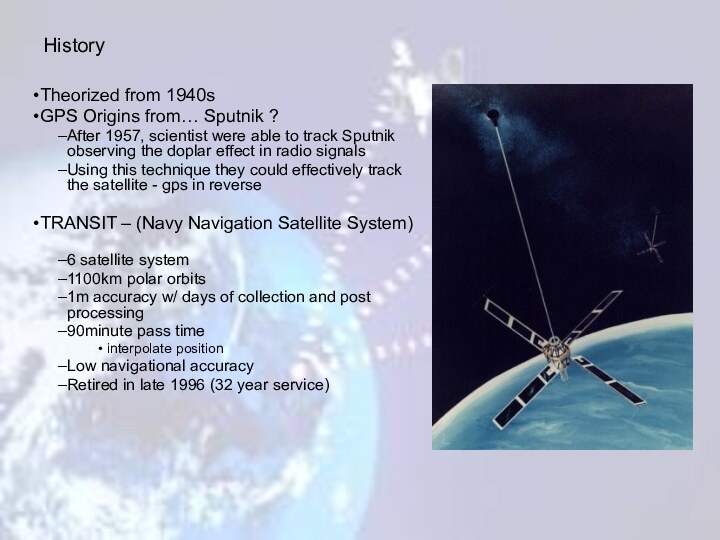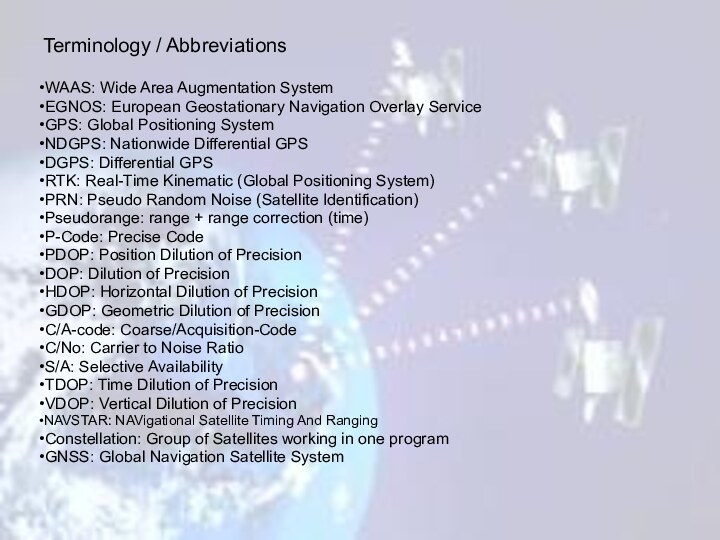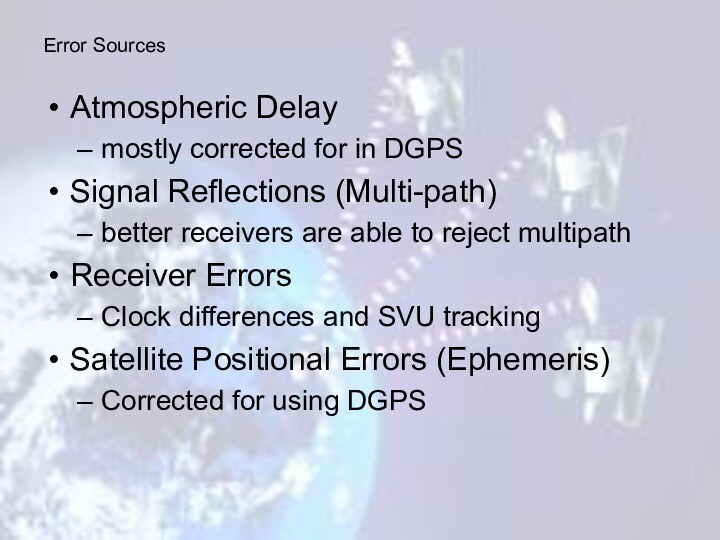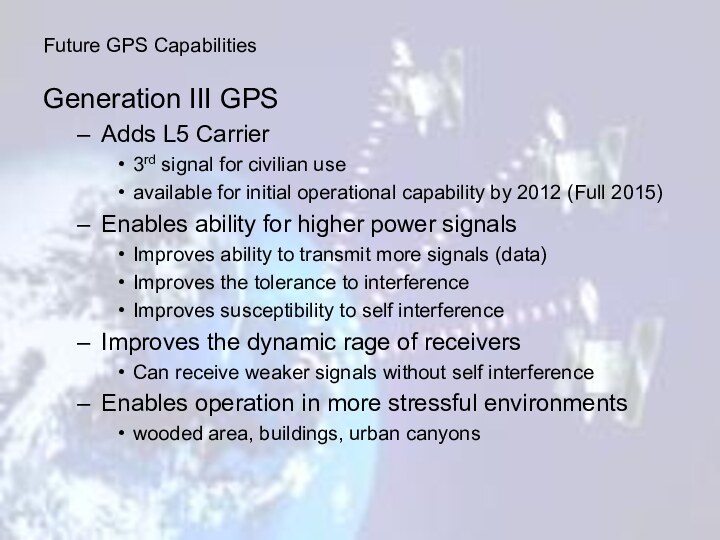- Главная
- Разное
- Бизнес и предпринимательство
- Образование
- Развлечения
- Государство
- Спорт
- Графика
- Культурология
- Еда и кулинария
- Лингвистика
- Религиоведение
- Черчение
- Физкультура
- ИЗО
- Психология
- Социология
- Английский язык
- Астрономия
- Алгебра
- Биология
- География
- Геометрия
- Детские презентации
- Информатика
- История
- Литература
- Маркетинг
- Математика
- Медицина
- Менеджмент
- Музыка
- МХК
- Немецкий язык
- ОБЖ
- Обществознание
- Окружающий мир
- Педагогика
- Русский язык
- Технология
- Физика
- Философия
- Химия
- Шаблоны, картинки для презентаций
- Экология
- Экономика
- Юриспруденция
Что такое findslide.org?
FindSlide.org - это сайт презентаций, докладов, шаблонов в формате PowerPoint.
Обратная связь
Email: Нажмите что бы посмотреть
Презентация на тему GPS
Содержание
- 2. Part I - Course OutlineGPS FundamentalsHistory TechnologySatellitesSignalsGround StationsReceiversUsers / UsesOther GPS SystemsThe Future of GPS
- 3. Part II - Course OutlineGPS Show and
- 4. Theorized from 1940sGPS Origins from… Sputnik ?After
- 5. U.S. Global Positioning System (GPS!)Navigational AidContinuous operation
- 6. Velocity x Time = Distance Satellites in
- 7. Timing is critical to determine distanceSatellites Contain
- 8. Timing is critical to determine distanceSatellites Contain
- 9. WAAS: Wide Area Augmentation SystemEGNOS: European Geostationary
- 10. Built by Lockheed Martin and Boeing North
- 13. Full Constellation24 satellite vehicle units (SVU)21 active
- 14. Satellite Diagram12,551mile altitude 24 Satellites6 Orbital PlanesThe Aerospace Corporation - "GPS Primer"
- 15. Block I original NAVSTAR constellationActive from 1978-198511
- 16. Satellites Broadcast Signals For Two Civil FrequenciesL1
- 17. Satellite SignalsCivilian codeC/A Code: Course/ Acquisition codeMilitary
- 18. Each Satellite transmits a timing signal called
- 19. Multiple Tracking StationsCentral Control Station Schriever AFB
- 20. HandheldAuto NavigationAir NavigationMarine NavigationCellular PhoneTrackingOnStar * (WAAS enabled 2008)http://www.ags.gov.ab.ca/activities/Turtle_Mountain/gps.htmReceiver Types
- 21. Receiver Types -
- 22. Atmospheric Delaymostly corrected for in DGPSSignal Reflections
- 23. Summary of GPS Error SourcesTypical Error (in
- 24. Differential GPS NDGPS - Nationwide Differential GPSU.S.
- 25. Being Developed with FAA for Air nav
- 26. Agriculture ConstructionMapping / GIS Military – Guidance / NavigationNavigationSurveyTime Keeping Network SynchronicityMany OthersGPS Users
- 27. Agriculture – Planting Construction – GPS Controlled Grading
- 28. Marine – Military
- 29. Kinematic GPSUses a stationary Receiver at a
- 30. To get initialized, RTK needs a minimum
- 31. GLONASS – Russia14 Satellites Last three launched
- 32. Скачать презентацию
- 33. Похожие презентации















![GPS Satellites Broadcast Signals For Two Civil FrequenciesL1 Broadcasts 50 watt signal;1575.42MHz [UHF]L2C](/img/tmb/15/1475328/a59c38cdcf51664a397611ff7a64c9cd-720x.jpg)
















Слайд 2
Part I - Course Outline
GPS Fundamentals
History
Technology
Satellites
Signals
Ground Stations
Receivers
Users
/ Uses
Слайд 3
Part II - Course Outline
GPS Show and Tell
Hands
On
Users Discussion
GPS Operation and Tasks
GPS Data Collection
Mission planning
Data dictionaries
Data
accuracy Importing GPS Data into ArcMap
GPS Accuracy
Limitations
Слайд 4
Theorized from 1940s
GPS Origins from… Sputnik ?
After 1957,
scientist were able to track Sputnik observing the doplar
effect in radio signalsUsing this technique they could effectively track the satellite - gps in reverse
TRANSIT – (Navy Navigation Satellite System)
6 satellite system
1100km polar orbits
1m accuracy w/ days of collection and post processing
90minute pass time
interpolate position
Low navigational accuracy
Retired in late 1996 (32 year service)
History
Слайд 5
U.S. Global Positioning System (GPS!)
Navigational Aid
Continuous operation (24/7/356)
All
weather / Line of Site
The only Free Global Utility
Unlimited
Number of Simultaneous UsersSatellite / Receiver based system
Developed by the DoD and US Navy
Operated by:
Military: Air Force Joint program Office
Civil: U.S. Coast Guard Navigation Center
Слайд 6
Velocity x Time = Distance
Satellites in orbit
transmit radio signals (code)
GPS Receivers are always tuned to
that frequencyReceivers are producing the same code for each satellite
Each signal is then timed to determine the delay between both signals
distance between receiver and the satellite is equal to the delay
Sort of…
Process is repeated for each satellite in view
Principle Concepts of GPS Technology
Слайд 7
Timing is critical to determine distance
Satellites Contain 4
atomic clocks each
Entire System is Synchronized
Receivers do not have
atomic clocksMust have at least 4 different satellites
Receivers use Triangulation algorithm from 3 satellites for position / with timing error
Hence the pseudo range = range + timing error
1 additional satellite used to calculate receivers time error (Algebra Equation)
Principle Concepts of GPS Technology
Слайд 8
Timing is critical to determine distance
Satellites Contain 4
atomic clocks each
Entire System is Synchronized
Receivers do not have
atomic clocks (but have atomic clock accuracy!)Must have at least 4 different satellites
Receivers use Triangulation algorithm from 3 satellites for position / with timing error
Hence the pseudo range = range + timing error
1 additional satellite used to calculate receivers time error (Algebra Equation)
Principle Concepts of GPS Technology
Слайд 9
WAAS: Wide Area Augmentation System
EGNOS: European Geostationary Navigation
Overlay Service
GPS: Global Positioning System
NDGPS: Nationwide Differential GPS
DGPS: Differential GPS
RTK: Real-Time Kinematic (Global Positioning System)
PRN: Pseudo Random Noise (Satellite Identification)
Pseudorange: range + range correction (time)
P-Code: Precise Code
PDOP: Position Dilution of Precision
DOP: Dilution of Precision
HDOP: Horizontal Dilution of Precision
GDOP: Geometric Dilution of Precision
C/A-code: Coarse/Acquisition-Code
C/No: Carrier to Noise Ratio
S/A: Selective Availability
TDOP: Time Dilution of Precision
VDOP: Vertical Dilution of Precision
NAVSTAR: NAVigational Satellite Timing And Ranging
Constellation: Group of Satellites working in one program
GNSS: Global Navigation Satellite System
Terminology / Abbreviations
Слайд 10 Built by Lockheed Martin and Boeing North American
(Rockwell Int.)
Powered by Solar Panels
800watts / ( Block IIF
2450 watts)Designed to last for 7.5 – 11years
Weighs 3,600lbs – 4,480lbs
(2006 4 door Honda Accord is 3,400lbs)
In 12,000 Mile Orbits
12 hr orbit period (pass time)
General Satellite Information
Слайд 13
Full Constellation
24 satellite vehicle units (SVU)
21 active
3
hot spares
http://www.navcen.uscg.gov/ftp/GPS/status.txt
http://www.spaceandtech.com/spacedata/constellations/navstar-gps_consum.shtml
Four Generations of GPS Satellites
Block I
Block II/ IIA
Block
IIR Block IIF
Constellation Information
Слайд 14
Satellite Diagram
12,551mile altitude
24 Satellites
6 Orbital Planes
The Aerospace
Corporation - "GPS Primer"
Слайд 15
Block I
original NAVSTAR constellation
Active from 1978-1985
11 Satellite
System
Polar Orbits
Used to test Principals and Technologies of
GPSBlock II / IIA
First operational GPS constellation
(solely for military use in the beginning)
Block IIR, IIR-M (current satellites)
R-Replenishment (used to replace older Block II satellites)
M-Modernized (updated version of the GPS Satellite)
Block IIF
Satellites scheduled for launch 2008
Current Satellites of the System Being Replaced by Block IIF
Will include the L5 Carrier
Constellation Information
Слайд 16
Satellites Broadcast Signals For Two Civil Frequencies
L1 Broadcasts
50 watt signal;1575.42MHz [UHF]
L2C Broadcasts - 1227.6 MHz [UHF]
L2
C (civil)Signal Strength is approximately same strength as earths own natural background noise
Receivers that obtain both L1 and L2 signals are referred to as dual-frequency receivers
Multi-Channel refers to the actual satellite (one satellite frequency in each channel)
Tri-frequency –(new receivers?)
Satellites Signals – Pseudo random code
Слайд 17
Satellite Signals
Civilian code
C/A Code: Course/ Acquisition code
Military code
P-Code
(precision code)
Y-Code (precision code encrypted)
Almanac Information
Signal Contains Satellite Location
Information for all satellites Repeating Binary Code
This serves as a unique satellite ID
Слайд 18 Each Satellite transmits a timing signal called a
Pseudo Random Code
Also referred to PRN (Pseudo Random
Noise)Repeating Binary Code
Serves as a unique satellite ID
Satellite Signal - Pseudo Random Code
Слайд 19
Multiple Tracking Stations
Central Control Station
Schriever AFB Colorado
(50th Space Wing of the USAF)
Tracks SVU Health (telemetry
data)Tracks SVUs Position (Ephemeris Data)
Satellite Orbits are effected by gravity from the earth, moon and sun. Also effected by pressure of solar radiation
Maintains Clock Synchronization between SVUs
Transmits Flight Correction Commands
Almanac Data
Updates each satellite with it’s own corrected position and the corrected position of the constellation.
Ground Control
Слайд 20
Handheld
Auto Navigation
Air Navigation
Marine Navigation
Cellular Phone
Tracking
OnStar * (WAAS enabled
2008)
http://www.ags.gov.ab.ca/activities/Turtle_Mountain/gps.htm
Receiver Types
Слайд 22
Atmospheric Delay
mostly corrected for in DGPS
Signal Reflections (Multi-path)
better
receivers are able to reject multipath
Receiver Errors
Clock differences and
SVU trackingSatellite Positional Errors (Ephemeris)
Corrected for using DGPS
Error Sources
Слайд 23
Summary of GPS Error Sources
Typical Error (in Meters)
Standard GPS Differential GPS
Satellite
Clocks 1.5 0 Orbit Errors 2.5 0
Ionosphere 5.0 0.4
Troposphere 0.5 0.2
Receiver Noise 0.3 0.3
Multipath 0.6 0.6
Typical Error Budget
Слайд 24
Differential GPS
NDGPS - Nationwide Differential GPS
U.S. Coast Guard
Operates a National System
Used for Navigation and Harbor Navigation
System
of 85 un-manned beacon transmitting sites 2 Manned Master Control Stations
Receives GPS Signal and re-transmitts atmosphere error clock error correction information
Must use a DGPS beacon receiver AND a GPS receiver
>3m accuracy
Слайд 25
Being Developed with FAA for Air nav use
Not
currently accurate enough for precision approach
Provides >3m accuracy
2 Geostationary
SVUs broadcast on L1Transmits Location and Correction
Uses Ground Station Information for correction
24 + ground stations
2 master stations (one on each coast)
WAAS - Wide Area Augmentation System
Слайд 26
Agriculture
Construction
Mapping / GIS
Military – Guidance /
Navigation
Navigation
Survey
Time Keeping
Network Synchronicity
Many Others
GPS Users
Слайд 29
Kinematic GPS
Uses a stationary Receiver at a known
location
Corrects for atmospheric errors
Ephemeris errors / other
Centimeter Accuracy in
horizontal and vertical accuracyDual Frequency Receivers
Must have your own base station within close proximity to your collection site
Слайд 30 To get initialized, RTK needs a minimum of
five satellites. After that it can operate with four.
DGPS needs a minimum of three, though at least four are required for submeter accuracy.For RTK, you need a dual frequency GPS receiver. Single frequency receivers are sufficient for DGPS.
For RTK, your GPS receiver must be capable of On-the-Fly initialization (obtaining centimeter accuracy while moving). For DGPS, this isn't necessary.
With RTK, it takes one minute to initialize. DGPS receivers initialize immediately.
You can expect accuracy of a few centimeters in all three dimensions using RTK. With DGPS, you can achieve sub-meter accuracy in horizontal position only.
To obtain GPS corrections for RTK, you need your own base station that is no more than ten kilometers from the field you are working in. For DGPS, you can use your own base station, a correction service provider, or make use of the free radio beacon broadcasts in many regions.
Difference between DGPS & RTK (Trimble Website)
Слайд 31
GLONASS – Russia
14 Satellites
Last three launched in
June 2005
3 Orbital Planes
Galileo – Europe
30 Satellites
23 222 km
/ 75,459ft / 14.2miles14 hour orbit
Better polar coverage
Search and Rescue function
transponds distress signals / reply
Anticipated fully operational 2008
Other GPS Systems





























